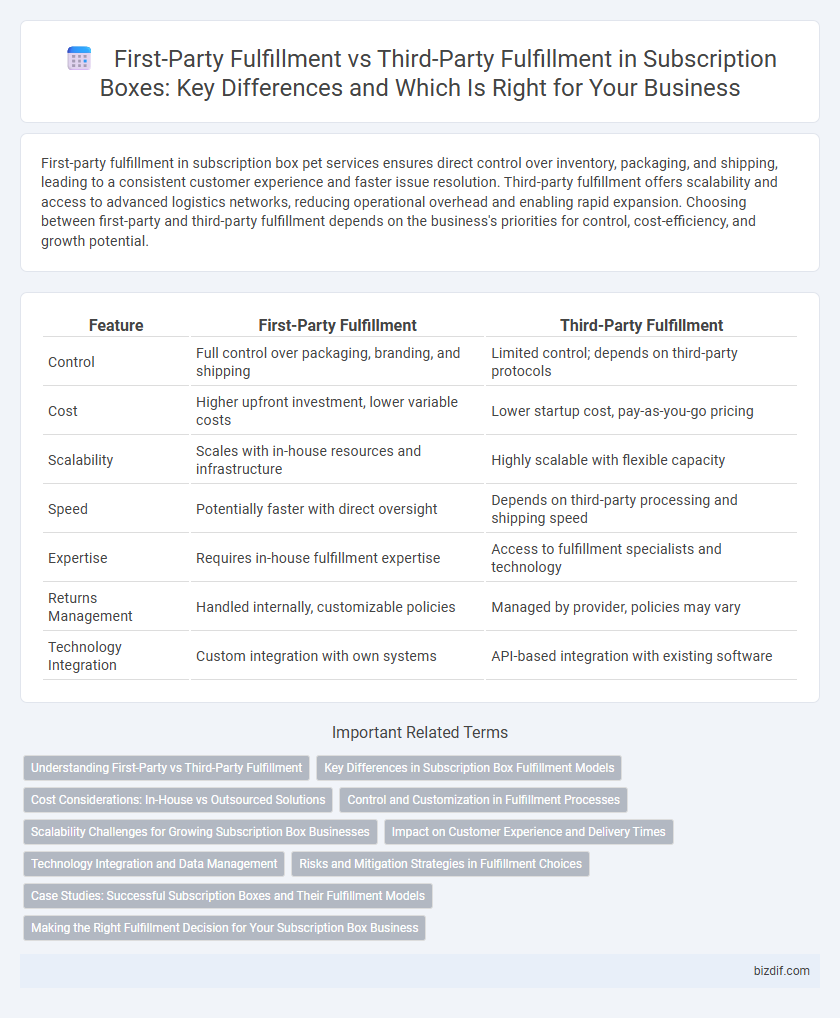First-party fulfillment in subscription box pet services ensures direct control over inventory, packaging, and shipping, leading to a consistent customer experience and faster issue resolution. Third-party fulfillment offers scalability and access to advanced logistics networks, reducing operational overhead and enabling rapid expansion. Choosing between first-party and third-party fulfillment depends on the business's priorities for control, cost-efficiency, and growth potential.
Table of Comparison
| Feature | First-Party Fulfillment | Third-Party Fulfillment |
|---|---|---|
| Control | Full control over packaging, branding, and shipping | Limited control; depends on third-party protocols |
| Cost | Higher upfront investment, lower variable costs | Lower startup cost, pay-as-you-go pricing |
| Scalability | Scales with in-house resources and infrastructure | Highly scalable with flexible capacity |
| Speed | Potentially faster with direct oversight | Depends on third-party processing and shipping speed |
| Expertise | Requires in-house fulfillment expertise | Access to fulfillment specialists and technology |
| Returns Management | Handled internally, customizable policies | Managed by provider, policies may vary |
| Technology Integration | Custom integration with own systems | API-based integration with existing software |
Understanding First-Party vs Third-Party Fulfillment
First-party fulfillment involves the subscription box company managing inventory, packing, and shipping directly to customers, ensuring greater control over branding and customer experience. Third-party fulfillment outsources these logistics to specialized warehouses or fulfillment centers, allowing companies to scale operations quickly and reduce overhead costs. Understanding the trade-offs between control, cost-efficiency, and scalability helps subscription box businesses choose the fulfillment strategy that best aligns with their growth goals.
Key Differences in Subscription Box Fulfillment Models
First-party fulfillment in subscription boxes involves the brand managing warehousing, packing, and shipping internally, ensuring direct control over inventory and customer experience. Third-party fulfillment outsources these operations to specialized logistics providers, enhancing scalability and reducing overhead costs but sacrificing some control and customization. Key differences include control over quality, cost structure, and flexibility in handling fluctuating subscription volumes.
Cost Considerations: In-House vs Outsourced Solutions
First-party fulfillment involves managing inventory, packaging, and shipping internally, which can reduce long-term costs but requires significant upfront investment in infrastructure and labor. Third-party fulfillment services offer scalable solutions with variable costs based on order volume, often lowering initial expenses but potentially increasing per-unit costs due to fees and less control over customization. Evaluating cost efficiency depends on subscription box business size, order frequency, and the balance between control and operational expenses.
Control and Customization in Fulfillment Processes
First-party fulfillment offers brands complete control over inventory management, order processing, and packaging, enabling highly customized subscription box experiences tailored to customer preferences. Third-party fulfillment services provide scalability and operational efficiency but may limit the level of customization and direct oversight on quality control during packing and shipping. Choosing between first-party and third-party fulfillment hinges on prioritizing operational control and the degree of personalized customer experience in the subscription box model.
Scalability Challenges for Growing Subscription Box Businesses
First-party fulfillment requires businesses to manage inventory, packing, and shipping internally, which can become increasingly complex and resource-intensive as subscription box orders scale. Third-party fulfillment partners offer specialized infrastructure and expertise that enable faster order processing and handling of fluctuating demand, reducing operational bottlenecks. However, reliance on third-party services may introduce challenges in quality control and communication, impacting customer experience during rapid growth phases.
Impact on Customer Experience and Delivery Times
First-party fulfillment allows subscription box companies to maintain direct control over inventory, packaging, and shipping processes, resulting in faster delivery times and a more personalized customer experience. Third-party fulfillment, while offering scalability and reduced operational burden, may introduce longer delivery times and less customization, potentially impacting customer satisfaction. Efficient communication and integration between subscription services and third-party logistics providers are crucial to minimizing delays and ensuring a consistent brand experience.
Technology Integration and Data Management
First-party fulfillment allows direct integration with subscription box companies' proprietary technology platforms, enabling real-time inventory tracking, personalized data analytics, and seamless customer experience management. Third-party fulfillment providers often offer advanced API compatibility to connect with various e-commerce and CRM systems, enhancing data synchronization and operational efficiency across multiple channels. Efficient data management through these integrations ensures accurate order processing, reduces delays, and supports tailored marketing strategies based on consumer behavior insights.
Risks and Mitigation Strategies in Fulfillment Choices
First-party fulfillment offers greater control over inventory and customer experience but carries risks such as high operational costs and scalability challenges. Third-party fulfillment reduces overhead and leverages specialized logistics but may result in less control over delivery speed and product handling, increasing risks of fulfillment errors. Mitigation strategies include implementing robust communication protocols, integrating real-time inventory management systems, and routinely auditing fulfillment partners to ensure service quality and compliance.
Case Studies: Successful Subscription Boxes and Their Fulfillment Models
Successful subscription boxes like BarkBox and FabFitFun illustrate the impact of fulfillment models on customer satisfaction and scalability. BarkBox utilizes first-party fulfillment to maintain control over packaging and quality, resulting in a highly personalized customer experience and consistent brand loyalty. FabFitFun leverages third-party fulfillment to efficiently manage large-scale distribution, enabling rapid growth and international expansion without compromising delivery speed.
Making the Right Fulfillment Decision for Your Subscription Box Business
Choosing first-party fulfillment offers direct control over inventory and customer experience, ensuring greater customization and faster issue resolution for subscription box businesses. Third-party fulfillment provides scalability and access to sophisticated logistics infrastructure without the need for upfront investment, ideal for handling growing order volumes efficiently. Evaluating factors like cost, control preferences, and business growth projections is essential to making the right fulfillment decision tailored to your subscription box model.
First-party fulfillment vs Third-party fulfillment Infographic

 bizdif.com
bizdif.com